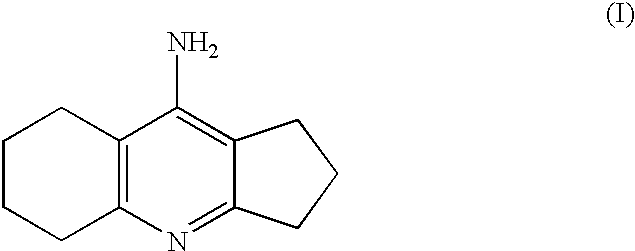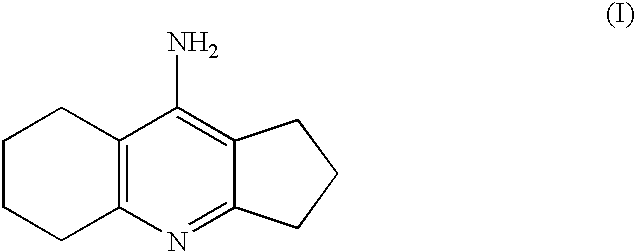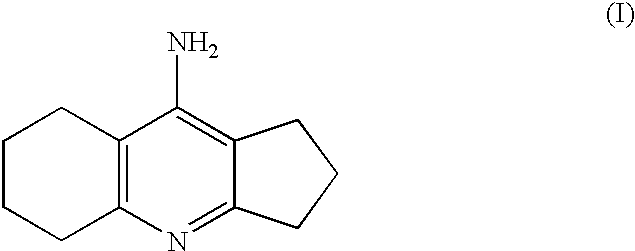Process for the preparation of ipidacrine or ipidacrine hydrochloride hydrate
a technology of ipidacrine and hydrochloride hydrate, which is applied in the field of process for the preparation of ipidacrine or ipidacrine hydrochloride hydrate, can solve the problems of inconvenient mass production, process described in japanese patent, and inconvenient mass production, and achieves the effect of easy complete removal
- Summary
- Abstract
- Description
- Claims
- Application Information
AI Technical Summary
Benefits of technology
Problems solved by technology
Method used
Image
Examples
example 1
Synthesis of 9-amino-2,3,5.6,7.8-hexahvdro-1H-cyclopentafbiquinoline)
78.8 g (555 mmol) of diphosphorus pentaoxide (P.sub.2 O.sub.5) was suspended in 100 ml of toluene and raised in temperature to 55.degree. C. At that temperature, 78.6 ml (462 mmol) of triethyl phosphate was added dropwise, then 8.0 ml (139 mmol) of ethanol was added dropwise and stirred for 30 minutes. The solution was cooled to 20.degree. C., 10.0 g (92.5 mmol) of 2-amino-1-cyclopentene-1-carbonitrile and 10.1 ml (97.1 mmol) of cyclohexanone were added, then the solution was stirred at 55.degree. C. for 3.5 hours. The solution was cooled, then 200 ml of water was added dropwise at not more than 40.degree. C. and stirred at 55.degree. C. for 30 minutes. The aqueous phase was separated and the toluene phase was washed with 100 ml of water. The resultant aqueous phase was combined with the previously separated aqueous phase.
The aqueous phase was added dropwise into 400 ml of a concentrated ammonia water solution and ...
example 2
Synthesis of Ipidacrine (i.e. 9-Amino-2,3,5,6,7,8-hexahydro-1H-cyclopenta[b]quinoline)
394 g (2774 mmol) of diphosphorus pentaoxide (P.sub.2 O0) was suspended in 500 ml of toluene and raised in temperature to 55.degree. C. At that temperature, 283 ml (1665 mmol) of triethyl phosphate was added dropwise, then 75 ml (1295 mmol) of ethanol was added dropwise and the resultant mixture was stirred for 30 minutes. The solution was cooled to 30.degree. C., 50 g (462 mmol) of 2-amino-1-cyclopentene-1-carbonitrile and 50 ml (485 mmol) of cyclohexanone were added, then the solution was stirred at 55.degree. C. for 3.5 hours. The heating was stopped, 500 ml of water was added dropwise at not more than 55.degree. C., and the solution was stirred at 55.degree. C. for 30 minutes. The aqueous phase was separated and the toluene phase was washed by 250 ml of water. The resultant aqueous phase was combined with the previously separated aqueous phase.
The aqueous phase was added dropwise into 2000 ml o...
example 3
Synthesis of Ipidacrine Hydrochloride Hydrate (9-amino-2,3,5,6,7,8-hexahydro-1H-cyclolpenta[b]quinoline-hydrochloride Hydrate
40 g (212 mmol) of ipidacrine (i.e., 9-amino-2,3,5,6,7,8-hexahydro-1H-cyclopenta[b]quinoline) was heated and dissolved in a mixed solvent of 720 ml of acetone and 40 ml of water. 19 ml (212 mmol) of concentrated hydrochloric acid was added dropwise over 10 minutes. Further, the solution was heated under reflux for 30 minutes, then allowed to stand at room temperature overnight. The precipitated crystal was filtered, washed with acetone, then allowed to stand in the air to allow the deposited acetone to evaporate, and obtained 49 g (202 mmol) of the desired compound. The yield was 95%. The melting point was 274.degree. C. (decomposition).
PUM
| Property | Measurement | Unit |
|---|---|---|
| Volume | aaaaa | aaaaa |
| Volume | aaaaa | aaaaa |
| Volume | aaaaa | aaaaa |
Abstract
Description
Claims
Application Information
 Login to View More
Login to View More - R&D
- Intellectual Property
- Life Sciences
- Materials
- Tech Scout
- Unparalleled Data Quality
- Higher Quality Content
- 60% Fewer Hallucinations
Browse by: Latest US Patents, China's latest patents, Technical Efficacy Thesaurus, Application Domain, Technology Topic, Popular Technical Reports.
© 2025 PatSnap. All rights reserved.Legal|Privacy policy|Modern Slavery Act Transparency Statement|Sitemap|About US| Contact US: help@patsnap.com



